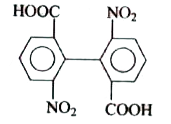Which of the following compounds after complete hydrogenation will form three monochloro structural isomeric products ?

CH3−CH−C−CH3 | || CH3 CH2

C≡CH |HC≡C−CH−C≡CH
The correct Answer is:C, D
To solve the question of which compound, after complete hydrogenation, will form three monochloro structural isomeric products, we can follow these steps:
Step 1: Identify the Compounds
We need to analyze the given compounds to determine their structures and how they would behave upon complete hydrogenation. The compounds are not explicitly listed in the question, but we can assume they are common organic compounds that can undergo hydrogenation.
Step 2: Perform Complete Hydrogenation
Complete hydrogenation of an unsaturated compound (like alkenes or alkynes) will convert it into a saturated compound (alkane). For example, if we have a compound like cyclohexene, hydrogenation will yield cyclohexane.
Step 3: Analyze the Resulting Alkane
Once we have the saturated alkane, we need to analyze its structure to see how many unique monochloro isomers can be formed. A monochloro isomer is formed when one hydrogen atom in the alkane is replaced by a chlorine atom.
Step 4: Count the Unique Monochloro Isomers
- If the resulting alkane has symmetrical groups, the number of unique monochloro isomers will be fewer.
- If the resulting alkane has different groups or positions where chlorine can be substituted, the number of unique isomers will increase.
Example Analysis
1. Cyclohexane: After hydrogenation, it remains cyclohexane. There is only one way to substitute a chlorine atom, resulting in only one monochloro isomer.
2. 2-Methylpentane: After hydrogenation, it becomes a saturated alkane. The possible monochloro isomers would be:
- Chlorination at the 2-position (2-chloro-2-methylpentane)
- Chlorination at the 3-position (3-chloro-2-methylpentane)
- Chlorination at the 4-position (4-chloro-2-methylpentane)
This results in three unique monochloro isomers.
3. 1-Hexene: After hydrogenation, it becomes hexane. The possible monochloro isomers would be:
- Chlorination at the 2-position (2-chlorohexane)
- Chlorination at the 3-position (3-chlorohexane)
- Chlorination at the 4-position (4-chlorohexane)
This results in three unique monochloro isomers.
Conclusion
After analyzing the compounds, the correct answer will be the compound that, after hydrogenation, yields an alkane with three unique positions for chlorination.
Final Answer
The compound that will form three monochloro structural isomeric products after complete hydrogenation is 2-Methylpentane or 1-Hexene.
We need to analyze the given compounds to determine their structures and how they would behave upon complete hydrogenation. The compounds are not explicitly listed in the question, but we can assume they are common organic compounds that can undergo hydrogenation.
Complete hydrogenation of an unsaturated compound (like alkenes or alkynes) will convert it into a saturated compound (alkane). For example, if we have a compound like cyclohexene, hydrogenation will yield cyclohexane.
Once we have the saturated alkane, we need to analyze its structure to see how many unique monochloro isomers can be formed. A monochloro isomer is formed when one hydrogen atom in the alkane is replaced by a chlorine atom.
- If the resulting alkane has symmetrical groups, the number of unique monochloro isomers will be fewer.
- If the resulting alkane has different groups or positions where chlorine can be substituted, the number of unique isomers will increase.
1. Cyclohexane: After hydrogenation, it remains cyclohexane. There is only one way to substitute a chlorine atom, resulting in only one monochloro isomer.
2. 2-Methylpentane: After hydrogenation, it becomes a saturated alkane. The possible monochloro isomers would be:
- Chlorination at the 2-position (2-chloro-2-methylpentane)
- Chlorination at the 3-position (3-chloro-2-methylpentane)
- Chlorination at the 4-position (4-chloro-2-methylpentane)
This results in three unique monochloro isomers.
- Chlorination at the 2-position (2-chlorohexane)
- Chlorination at the 3-position (3-chlorohexane)
- Chlorination at the 4-position (4-chlorohexane)
This results in three unique monochloro isomers.
After analyzing the compounds, the correct answer will be the compound that, after hydrogenation, yields an alkane with three unique positions for chlorination.
The compound that will form three monochloro structural isomeric products after complete hydrogenation is 2-Methylpentane or 1-Hexene.
Topper's Solved these Questions
- STRUCTURAL IDENTIFICATION & PRACTICAL ORGANIC CHEMISTRYBook:RESONANCE ENGLISHChapter:STRUCTURAL IDENTIFICATION & PRACTICAL ORGANIC CHEMISTRYExercise:Additional theory
Explore 4 Videos
- STRUCTURAL IDENTIFICATION & PRACTICAL ORGANIC CHEMISTRYBook:RESONANCE ENGLISHChapter:STRUCTURAL IDENTIFICATION & PRACTICAL ORGANIC CHEMISTRYExercise:Additional Exercise
Explore 15 Videos
- STRUCTURAL IDENTIFICATION & PRACTICAL ORGANIC CHEMISTRYBook:RESONANCE ENGLISHChapter:STRUCTURAL IDENTIFICATION & PRACTICAL ORGANIC CHEMISTRYExercise:APSP
Explore 30 Videos
- SOLID STATEBook:RESONANCE ENGLISHChapter:SOLID STATEExercise:Part- IV
Explore 21 Videos
- THERMODYNAMIC & THERMOCHEMISTRYBook:RESONANCE ENGLISHChapter:THERMODYNAMIC & THERMOCHEMISTRYExercise:INORGANIC CHEMISTRY(P-Block Elements)
Explore 26 Videos
Similar Questions
Knowledge Check
Which of the following compounds exhibit optical isomerism?
A BH2C=C=CH2C
BH2C=C=CH2C D
D
Which of the following compound shows optical isomerism ?
ACH3CH2CH3BCH2OHCHOHCH2OHCCH3CHOHC2H5DNone of theseWhich of the following compounds exhibits linkage isomerism?
A[Co(en)3]Cl3B[Co(NH3)6][Cr(en)3]C[Co(en)2(NO2)Cl]BrD[Co(NH3)5Cl]Br2
Which of the following compound show optical isomerism?
View SolutionWhich of the following compounds shows geometrical isomerism ?
View SolutionWhich of the following compounds display geomertical isomerism ?
View Solutionwhich of the following compound will show stereo isomerism?
View SolutionWhich of the following compound will show optical isomerism
View Solution
 Total number of monochloro structure products
Total number of monochloro structure products